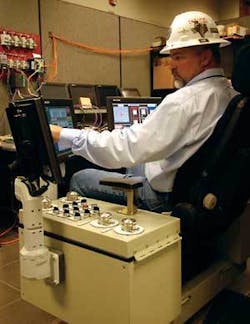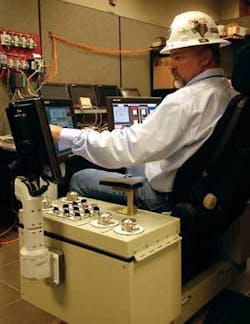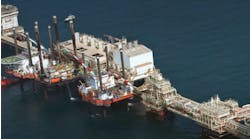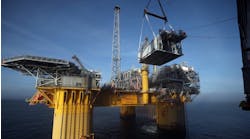Offshore exploration continues to move into deeper waters and drill to greater depths. This has placed greater demands on both power systems, which must provide ample power for the specialized needs of the offshore driller, and on drilling controls, which must provide real-time information to drillers and allow them to quickly adapt to changing conditions downhole. One company that keeps evolving its power and drilling technology to meet the evolving demands of the driller is OEM Power Systems.
Charles Piper in OEM’s DDCS chair.
Also known as OEM, this Houston-based subsidiary of Rowan Companies has been providing turnkey power systems to the drilling sector for several years. Since its purchase by Rowan in 2001, OEM has become a premier fabricator of drilling control systems for the industry including its parent company. One recent advance is the development of the Digital Drilling Control System, an automated program designed by drilling experts.
OEM developed the Digital Drilling Control System (DDCS) such that it could be effectively manipulated by both seasoned drillers who are used to the more conventional brake handle controls, and a newer generation of drillers who are comfortable with joystick and touchscreen monitors to control the drilling system.
“All the required work functions, from monitoring to drill job management and control of equipment, are managed on the DDCS,” says Charles Piper, controls engineer with OEM and an expert on the DDCS. “You can observe and control different parts of the drilling operation through the different touchscreen monitors on the console.”
“OEM has made the DDCS robust as well,” says Stella Horsup, sales application/quotation engineer for OEM. “The system can interface to existing and third party systems.” In addition, DDCS uses off-the-shelf software and components, making modifications easy to implement.
The heart of the DDCS is an ergonomic driller’s chair with joystick control and surrounded by a series of touchscreen monitors that allow for monitoring and control of various drilling systems. The control systems available on the DDCS include top drive and rotary management, drawworks management, power generation and control, mud system monitoring and mud pump control. Some of the features available for each control system include:
Drawworks management. The DDCS provides for weight on bit (WOB) and rate of penetration (ROP) setpoints for “autodrill” mode, as well as adjustable Hi and Low block stop setpoints. Static and dynamic stoppoints are available for true zone management, and the driller is able to calibrate block height and the joystick from the touchscreen monitor. The Kinetic Energy Management System (KEMS) monitors block position, direction, speed and hookload to assist in a managed DW braking system.
Top drive and rotary table management. During this application, the driller has full function hydraulic and electrical control of the system, and can adjust both the motor and wrench torque setpoints on-the-fly. The DDCS also gives the driller the power to link tilt, handling ring, IBOP, stand jump and brake monitoring and control together.
Mud pump and monitoring. A driller can control many facets of the mud pump, including auto synchronization of multiple pumps and master/slave pump selection and control. The DDCS also allows for standpipe pressure control, as well as stroke counter and summations, screen resets and logging.
The mud monitoring system provides real-time monitoring of casing and stand pipe pressures, as well as temperature of the choke line and the detection of any gases encountered. The system also provides hole volume and kill sheet calculations and reports, and allows the driller to calculate the required mud density, if necessary.
Power generation and control. The DDCS provides an array of power control and monitoring options at the driller’s fingertips. System load, both real and reactive, is provided, as is real-time power limit control with dynamic setpoints and alarms. A series of management, protection and alarm systems are provided for the engine/generator and winding/bearing systems. The driller is additionally able to monitor and record voltages, currents and power on screen. Real time monitoring and historical datalogging/trending of the power system are also provided.
Auxiliary operations control. The DDCS has a capability to control auxiliary systems such as pipe handling/racking systems and iron roughneck systems. The DDCS can be programmed to monitor and control other systems as required by the operator.
OEM manufactures and thoroughly tests each DDCS in its 250,000 sq ft plant and testing facility in Houston, Texas. In-house engineers such as Piper provide in-depth training to drillers on all aspects of the system utilizing a real time rig simulator and operational DDCS chair. “We hook up the system just as it would be in the field and let the driller run through all kinds of scenarios to really give them a feel for it,” says Piper.
The drilling community is taking notice of DDCS, as evidenced by the growing number of orders from customers in the Middle East, Asia, Russia, the GoM, and Brazil. As drillers keep demanding more flexibility and power out of the control systems, OEM seems ready and willing to deliver.
Ted Moon, Technology Editor




